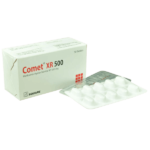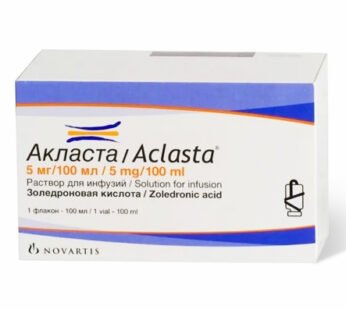Dicaltrol 0.25 mcg
Description
Indications
Dicaltrol is prescribed for the treatment of various bone and calcium metabolism disorders, including:
- Post-menopausal osteoporosis
- Renal osteodystrophy
- Postsurgical hypoparathyroidism
- Idiopathic hypoparathyroidism
- Pseudohypoparathyroidism
- Secondary hyperparathyroidism in patients with moderate to severe chronic renal failure (pre-dialysis)
- Vitamin D dependent rickets
Use only as directed by a registered physician.
Pharmacology
Calcitriol, the active metabolite of vitamin D3, is synthesized in the kidneys from its precursor, 25-hydroxycholecalciferol. It enhances calcium absorption in the intestines and regulates bone mineralization. Its primary function is to maintain calcium homeostasis, including stimulating osteoblastic activity in bones.
Dosage & Administration
The optimal daily dose of Calcitriol must be individualized based on serum calcium levels.
- Post-menopausal Osteoporosis: 0.25 mcg twice daily.
- Renal Osteodystrophy (Dialysis Patients): Initial dose of 0.25 mcg per day; in patients with normal or slightly reduced calcium levels, 0.25 mcg every other day may suffice.
- Hypoparathyroidism and Rickets: Initial dose of 0.25 mcg/day, taken in the morning. If response is inadequate after 2-4 weeks, the dose may be increased at 2-4 week intervals.
- Intravenous Administration for Hypocalcemia & Secondary Hyperparathyroidism: Initial dose of 1-2 mcg (0.02 mcg/kg), administered three times per week. Doses may range from 0.5 to 4 mcg three times per week, with adjustments every 2-4 weeks as needed.
Use only as directed by a registered physician.
Drug Interactions
- Thiazide diuretics: Increased risk of hypercalcemia.
- Digitalis therapy: Requires caution, as hypercalcemia may lead to cardiac arrhythmias.
- Magnesium-containing medications (e.g., antacids): May cause hypermagnesemia.
Contraindications
- Known hypersensitivity to Calcitriol or its components.
- Conditions associated with hypercalcemia.
Side Effects
- Early Side Effects: Weakness, headache, drowsiness, nausea, vomiting, dry mouth, constipation, muscle and bone pain, metallic taste.
- Late Side Effects: Increased urination and thirst, loss of appetite, weight loss, conjunctivitis, pancreatitis, skin irritation, hypertension, cardiac arrhythmias, rarely psychosis.
- Occasional mild injection-site pain has been reported.
Pregnancy & Lactation
Calcitriol does not show teratogenic effects in humans. It should only be used during pregnancy if benefits outweigh potential risks. Breastfeeding mothers may take Calcitriol, but maternal and infant serum calcium levels should be monitored.
Precautions & Warnings
- Excessive dosage may induce hypercalcemia and, in some cases, hypercalciuria.
- Patients on digitalis should be monitored for cardiac arrhythmias.
- Discontinuation of therapy should be done gradually to prevent rebound effects.
- Patients undergoing dialysis should use a non-aluminum phosphate binder to manage serum phosphorus levels.
- Chronic hypercalcemia can lead to vascular and soft tissue calcification.
Use in Special Populations
- Secondary Hyperparathyroidism (Pre-dialysis): Initial dose of 0.25 mcg/day in adults and children 3 years or older, with potential increase to 0.5 mcg/day.
- Children under 3 years: Initial dose of 10-15 ng/kg/day.
- Elderly: No dosage adjustment required.
Overdose Effects
Excessive administration can cause hypercalcemia, hypercalciuria, and hyperphosphatemia. Management includes discontinuation of therapy, a low-calcium diet, and withdrawal of calcium supplements.
Therapeutic Class
- Bone formation supplements
- Vitamin D preparations
Storage Conditions
- Store in a dry place, away from light and heat.
- Keep out of reach of children.
Additional information
| Weight | 0.15 g |
|---|








Reviews
There are no reviews yet.